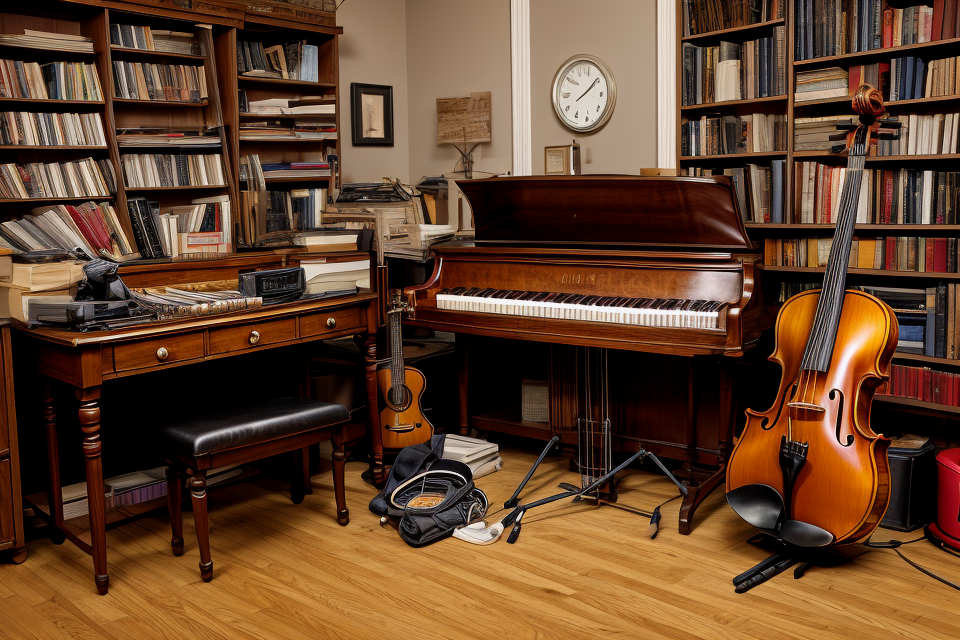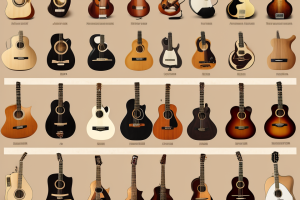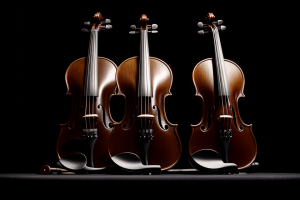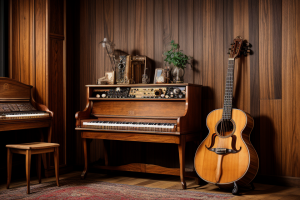
Are you a musician or an instrument enthusiast looking to keep your beloved instruments in top condition? Then you’ve come to the right place! Join us as we explore the fascinating world of instrument care and learn from the expert on how to properly maintain your musical companions. Whether you’re a beginner or a seasoned pro, this guide will provide you with valuable insights on how to keep your instruments in top shape, so you can continue to make beautiful music for years to come. So, grab your instrument of choice and let’s get started!
The Importance of Instrument Preservation
The Cost of Neglecting Instrument Care
While it may seem like a small task, neglecting the care of your instruments can have serious consequences. As a professional musician, it is crucial to understand the importance of maintaining your instruments in order to avoid costly repairs and replacements. Here are some examples of the cost of neglecting instrument care:
- Damaged instruments: Failing to properly maintain your instruments can lead to damage that may require costly repairs or even replacement. This can be especially true for delicate instruments such as violins or woodwinds, which can be easily damaged if not handled correctly.
- Reduced resale value: Instruments that are not well-maintained may have a reduced resale value, which can be a significant loss for musicians who rely on the sale of their instruments to upgrade to better ones.
- Poor sound quality: Neglecting instrument care can result in poor sound quality, which can be frustrating for musicians who strive for the best possible sound. This can also impact your ability to perform at your best, which can be detrimental to your career.
- Health issues: Some instruments, such as brass instruments, can harbor harmful bacteria if not properly cleaned and maintained. This can lead to health issues for musicians who play these instruments regularly.
In conclusion, neglecting instrument care can have serious consequences for musicians. By understanding the importance of maintaining your instruments, you can avoid costly repairs and replacements, ensure that your instruments are in top condition, and ensure that you are able to perform at your best.
The Benefits of Proper Instrument Care
Proper instrument care is crucial for preserving the longevity and integrity of your musical instruments. Not only does it help maintain their appearance and value, but it also ensures that they continue to function properly and produce high-quality sound. Here are some specific benefits of practicing good instrument care:
- Protecting Your Investment: Instruments are often expensive investments, and proper care can help preserve their value. Regular maintenance can prevent damage and wear and tear, which can help maintain the instrument’s resale value.
- Improving Sound Quality: Regular cleaning and maintenance can help ensure that your instrument produces the best possible sound. Dirt, dust, and grime can accumulate on instruments and affect their sound quality, so it’s important to keep them clean.
- Extending Longevity: Proper care can help extend the lifespan of your instrument. This includes regular tuning, cleaning, and maintenance, as well as protecting the instrument from extreme temperatures and humidity.
- Reducing Risk of Damage: Instruments are delicate and can be easily damaged if not handled properly. By taking care of your instrument, you can reduce the risk of damage and ensure that it continues to function properly for years to come.
- Maintaining Appearance: Instruments can be beautiful works of art, and proper care can help maintain their appearance. This includes keeping them clean and free from dust and dirt, as well as protecting them from scratches and other types of damage.
Overall, proper instrument care is essential for any musician looking to preserve the value and functionality of their instruments. By taking the time to care for your instruments, you can ensure that they continue to produce high-quality sound and remain in good condition for years to come.
Basic Instrument Care
Cleaning Your Instrument
Regular cleaning is essential to the longevity and overall health of your instruments. Dust, dirt, and other debris can accumulate on your instrument, which can affect its sound quality and lead to damage over time. Here are some tips on how to clean your instrument properly:
Remove Dust and Debris
Before cleaning your instrument, remove any visible dust or debris using a soft, dry cloth. Gently wipe down the instrument’s surface to avoid damaging it.
Use a Soft, Damp Cloth
For a deeper clean, use a soft, damp cloth to wipe down the instrument. Avoid using harsh chemicals or abrasive materials, as these can damage the instrument’s finish or components. Instead, use a gentle cleaner or soap and water solution. Be sure to rinse the cloth thoroughly before using it to clean the instrument.
Dry the Instrument Properly
After cleaning, make sure to dry the instrument thoroughly. Use a soft cloth to pat down the surface gently, avoiding any areas that may be sensitive or delicate. If your instrument has electronic components, make sure to unplug it before cleaning to avoid any damage from moisture.
Consider Professional Cleaning
While regular cleaning is important, it’s also essential to have your instrument professionally cleaned and maintained periodically. A professional cleaning can help to remove any stubborn dirt or grime that may have accumulated over time, as well as identify any potential issues that may need to be addressed.
Overall, cleaning your instrument is a crucial part of basic instrument care. By following these tips, you can help to ensure that your instrument stays in good condition and continues to produce high-quality sound for years to come.
Tuning Your Instrument
Maintaining the proper tuning of your instrument is essential for optimal performance. Whether you play the guitar, violin, or any other stringed instrument, regular tuning is necessary to ensure that your instrument sounds its best. Here are some tips from an expert on how to tune your instrument properly:
- Use a reliable tuner: A tuner is a device that helps you determine whether your instrument is in tune or not. There are various types of tuners available, including clip-on tuners, pedal tuners, and tuning forks. It’s essential to use a reliable tuner to ensure accurate results.
- Warm up your instrument: Before tuning your instrument, it’s important to warm it up by playing a few notes or using a rubber band to stretch the strings. This will help prevent the strings from breaking during tuning.
- Tune in a quiet environment: Tuning your instrument requires concentration and focus. It’s essential to find a quiet environment where you won’t be distracted by noise or other external factors.
- Start with the lowest string: When tuning your instrument, start with the lowest string and work your way up to the highest. This will help you hear the differences in pitch more clearly.
- Use a tuning fork: A tuning fork is a small metal instrument that produces a specific pitch when struck. You can use a tuning fork to help you tune your instrument by matching the pitch of the fork to the pitch of your strings.
- Tune in small increments: When tuning your instrument, it’s important to tune in small increments rather than making large adjustments. This will help you hear the differences in pitch more clearly and ensure that your instrument stays in tune for longer.
- Check the tuning regularly: Regularly checking the tuning of your instrument is essential to ensure that it stays in tune. Make it a habit to tune your instrument before every practice session or performance.
By following these tips from an expert, you can ensure that your instrument stays in tune and sounds its best. Regular tuning is a simple but essential part of basic instrument care that every musician should follow.
Storing Your Instrument
Proper storage is crucial for the longevity and maintenance of your instruments. Follow these guidelines to ensure your instruments remain in top condition:
- Choose the right storage space: Select a dry, cool, and stable environment for storing your instruments. Avoid storing them in areas with extreme temperatures, direct sunlight, or moisture. Ideally, a closet or a case specifically designed for musical instrument storage is best.
- Maintain proper humidity: Extreme changes in humidity can cause damage to your instrument. Aim for a relative humidity between 40-60% to prevent cracking or warping. You can use a hygrometer to monitor the humidity levels in your storage space.
- Adjust for seasonal changes: During sudden temperature or humidity changes, gradually adjust the environment around your instrument to prevent shock. For example, if you’re moving your instrument from a hot car to an air-conditioned room, allow it to adjust gradually to prevent damage.
- Regularly inspect your instrument: Before storing your instrument, give it a thorough cleaning and inspection. Look for any signs of damage, such as cracks or warping, and address them promptly.
- Protect your instrument during transport: When traveling with your instrument, ensure it is properly packed and padded to prevent damage. Consider investing in a high-quality case or bag designed for your specific instrument.
- Consider professional storage options: If you don’t have a suitable storage space or plan to store your instrument for an extended period, consider hiring a professional storage service specializing in musical instruments. These services often provide climate-controlled storage, insurance, and maintenance.
By following these guidelines, you can ensure that your instruments remain in optimal condition and are ready for years of continued use and enjoyment.
Advanced Instrument Care
Humidification and Dehumidification
Proper humidification and dehumidification are crucial in ensuring the longevity and optimal performance of your instruments. Both processes help maintain the ideal moisture level within the instrument, preventing cracks and damage caused by extreme dryness or dampness.
Humidification
Humidification involves adding moisture to the instrument to prevent it from drying out. There are different methods for humidifying your instrument, including using a humidifier or placing the instrument in a sealed container with a damp sponge or cloth.
It is important to note that not all woods can tolerate high levels of humidity. Some woods, such as maple and rosewood, are more resistant to changes in humidity than others, like spruce and cedar. When humidifying your instrument, it is best to use a hygrometer to monitor the humidity level and avoid exposing your instrument to extremes.
Dehumidification
Dehumidification, on the other hand, involves removing excess moisture from the instrument. This process is especially important during the summer months when the air tends to be more humid. Dehumidification can be achieved by placing the instrument in an air-conditioned room or using a dehumidifier.
When using a dehumidifier, it is important to ensure that the instrument is not exposed to sudden changes in temperature or humidity. Gradual changes are less likely to cause damage to the instrument. It is also important to monitor the humidity level of the environment where the instrument is stored to prevent it from becoming too dry.
In conclusion, humidification and dehumidification are crucial in ensuring the optimal performance and longevity of your instruments. By using the right methods and monitoring the humidity level, you can prevent damage to your instrument and enjoy playing it for years to come.
Polishing and Waxing
Polishing and waxing are important steps in maintaining the condition of your instruments. Proper care will help prevent damage, keep your instruments in good condition, and ensure they sound their best. Here are some tips for polishing and waxing your instruments:
- Use a soft, dry cloth to clean your instruments after each use. This will remove any moisture and help prevent damage to the finish.
- For wood instruments, use a soft, dry cloth to wipe away any dust or dirt. Avoid using alcohol or other chemicals, as they can damage the finish.
- For metal instruments, use a soft, dry cloth to wipe away any dust or dirt. You can also use a microfiber cloth to remove any fingerprints or smudges.
- When polishing your instruments, use a soft, lint-free cloth and a polishing cloth. Start with a light touch and gradually increase the pressure until the desired shine is achieved. Be sure to avoid scratching the finish.
- For a deeper shine, use a wax-based polish specifically designed for your instrument. Apply a small amount to a soft cloth and work it into the finish in a circular motion. Use a clean, dry cloth to remove any excess polish.
- When waxing your instruments, start with a small amount of wax and apply it to a soft cloth. Work it into the finish in a circular motion, then use a clean, dry cloth to remove any excess wax.
- Allow the wax to dry completely before playing your instrument. This will help prevent damage to the finish and ensure your instrument sounds its best.
By following these tips, you can keep your instruments in good condition and ensure they sound their best. Remember to always use the right polish and wax for your instrument, and avoid using chemicals or abrasive materials that could damage the finish.
Repairing and Maintaining Mechanical Parts
Proper repair and maintenance of mechanical parts are crucial in ensuring the longevity and optimal performance of your instruments. Here are some tips from an expert on how to effectively repair and maintain mechanical parts of your instruments:
- Identify the problem: Before attempting any repairs, it is essential to identify the problem accurately. This may involve examining the instrument’s mechanical parts and determining whether the issue is due to a lack of lubrication, a broken component, or any other issue.
- Clean the instrument: Dirt, dust, and debris can accumulate in the mechanical parts of an instrument, causing friction and impeding its performance. It is essential to clean the instrument regularly, using a soft cloth or brush to remove any buildup.
- Lubricate the instrument: Lubricating the mechanical parts of an instrument can help to reduce friction and improve its performance. This can be done using a lubricant specifically designed for musical instruments, such as silicone oil or a lubricating spray.
- Repair broken components: If an instrument’s mechanical parts are broken, it may need to be repaired by a professional. This may involve replacing broken components or repairing damaged parts.
- Maintain the instrument regularly: Regular maintenance of an instrument’s mechanical parts can help to prevent future problems and ensure optimal performance. This may involve checking for worn or damaged components and replacing them as needed.
By following these tips, you can effectively repair and maintain the mechanical parts of your instruments, ensuring their longevity and optimal performance.
Choosing the Right Accessories
Choosing the Right Case
When it comes to choosing the right case for your instrument, there are several factors to consider. Here are some tips to help you make the best decision:
- Material: The material of the case is an important factor to consider. Cases made of hardshell materials like carbon fiber or polycarbonate are generally more durable and provide better protection against impacts and external factors such as temperature and humidity. Soft cases, on the other hand, are usually lighter and more compact, making them a good choice for instruments that are easier to carry around.
- Size: It’s important to choose a case that fits your instrument perfectly. A case that’s too small may not provide enough protection, while a case that’s too large may make it difficult to carry your instrument around. Measure your instrument carefully before choosing a case to ensure a perfect fit.
- Design: The design of the case can also be an important factor. Some cases have built-in features like wheels or shoulder straps, which can make it easier to transport your instrument. Other cases may have special compartments for accessories or extra padding for added protection. Consider what features are most important to you when choosing a case.
- Brand: Finally, it’s important to choose a case from a reputable brand. While price may be a factor, it’s important to remember that a higher-quality case can provide better protection for your instrument and potentially save you money in the long run by preventing damage. Do some research and read reviews before making a decision.
Choosing the Right Bow
When it comes to choosing the right bow for your instrument, there are several factors to consider. The bow you choose can have a significant impact on the sound and playability of your instrument. Here are some tips to help you choose the right bow:
- Material: The material of the bow is an important factor to consider. The most common materials for bows are pernambuco, carbon fiber, and fiberglass. Pernambuco is the traditional material for bows and is known for its excellent responsiveness and balance. Carbon fiber and fiberglass bows are more durable and less expensive, but may not provide the same level of responsiveness as a pernambuco bow.
- Weight: The weight of the bow is also an important consideration. A heavier bow can provide more power and control, but may be more difficult to handle for some players. A lighter bow may be easier to handle, but may not provide as much power and control.
- Length: The length of the bow is also important. A longer bow can provide more power and reach, but may be more difficult to handle for some players. A shorter bow may be easier to handle, but may not provide as much power and reach.
- Hair: The type of hair used on the bow can also affect the sound and playability of the instrument. Horsehair is the traditional material for bow hair, but synthetic materials such as fiberglass or carbon fiber can also be used. Some players prefer the warm, rich sound of horsehair, while others prefer the consistency and durability of synthetic materials.
- Grip: The grip of the bow is also important. A comfortable grip can help prevent hand fatigue and improve control. Some players prefer a rounded grip, while others prefer a more pointed grip.
Overall, choosing the right bow for your instrument requires careful consideration of these factors. It is important to try out different bows to find the one that best suits your playing style and preferences. A skilled luthier or instrument repair professional can help guide you in choosing the right bow for your instrument.
Choosing the Right Rosin
Selecting the appropriate rosin for your instrument is crucial to ensure optimal performance and sound quality. There are various types of rosin available, each designed for specific instruments and playing styles. Here are some tips to help you choose the right rosin for your instrument:
- Know your rosin options: Rosin comes in different forms, including liquid, paste, and powder. Each type has its own benefits and drawbacks, so it’s essential to understand the differences before making a purchase.
- Consider the instrument: Different instruments require different types of rosin. For example, violinists typically use a dark rosin, while cellists prefer a lighter rosin. It’s important to choose a rosin that is specifically designed for your instrument to achieve the best results.
- Check the rosin hardness: Rosin hardness is typically classified as hard, medium, or soft. The hardness of the rosin affects the bow’s grip on the string, so it’s important to choose a rosin that complements your playing style. For example, a harder rosin is suitable for players who prefer a faster bow speed, while a softer rosin is better for slower, more controlled playing.
- Consider the playing environment: The humidity and temperature of the playing environment can affect the performance of your rosin. For example, a harder rosin may be more suitable for dry environments, while a softer rosin may be better for humid conditions.
- Experiment with different brands: There are many different brands of rosin available, each with its own unique characteristics. Experiment with different brands to find the one that works best for you and your instrument.
By following these tips, you can choose the right rosin for your instrument and achieve the best possible sound quality.
Common Problems and How to Solve Them
Fretbuzz and Fretwire Dressing
Fretbuzz is a common problem that guitar players face, and it occurs when the strings are out of alignment with the frets. This can cause a buzzing or rattling sound that can be frustrating to deal with. Fretwire dressing is the process of reshaping and smoothing out the frets to fix this problem.
To fix fretbuzz, the first step is to identify which frets are causing the issue. You can do this by using a tuner and playing each string while checking to see if the pitch changes. Once you have identified the problem frets, you can use a fret file or wire cutter to dress the frets. This involves filing down the high spots on the frets to level them out and remove any sharp edges.
It’s important to note that fretwire dressing should only be done by a professional if you’re not experienced with it. Improperly shaped frets can cause other problems and make your guitar difficult to play. If you’re not sure how to do it yourself, take your guitar to a professional repair shop.
Additionally, regular maintenance is key to preventing fretbuzz from becoming a problem in the first place. This includes cleaning your guitar regularly and making sure that the strings are properly tuned and aligned with the frets. By taking good care of your instrument, you can avoid many common problems and keep your guitar playing its best.
Cracked or Warped Instrument
Caring for your instruments is essential to ensure they remain in good condition and continue to produce quality sound. One common problem that can occur is a cracked or warped instrument. This can happen due to a variety of reasons, such as changes in temperature and humidity, excessive force when playing, or even regular wear and tear over time.
If you notice that your instrument has a crack or is warped, it is important to address the issue as soon as possible. Ignoring the problem can cause it to worsen over time, leading to more significant damage and potentially making the instrument unplayable.
Here are some tips on how to deal with a cracked or warped instrument:
- Seek professional help: If you notice that your instrument has a crack or is warped, it is important to seek professional help as soon as possible. A professional luthier or repair person can assess the damage and recommend the best course of action to repair the instrument.
- Avoid playing the instrument: If your instrument is cracked or warped, it is important to avoid playing it until it has been repaired. Continuing to play the instrument can cause further damage and potentially make the problem worse.
- Adjust humidity levels: Changes in temperature and humidity can cause instruments to crack or warp. If you notice that your instrument is warped, try adjusting the humidity levels in the room where the instrument is stored. A hygrometer can be helpful in monitoring the humidity levels.
- Use a humidifier or dehumidifier: If the humidity levels in the room are too low or too high, using a humidifier or dehumidifier can help prevent cracks and warping. It is important to monitor the humidity levels regularly to ensure that they remain within the appropriate range.
By following these tips, you can help prevent cracks and warping in your instrument and ensure that it remains in good condition for years to come.
Loose or Rattling Tuning Pins
When playing a stringed instrument, loose or rattling tuning pins can be a common problem that affects the sound quality and tuning stability. Fortunately, there are several ways to solve this issue and keep your instrument in top condition.
Cause of Loose Tuning Pins
Loose tuning pins can be caused by a variety of factors, including changes in temperature and humidity, excessive playing, and normal wear and tear. Over time, the pin can become loose or even fall out entirely, causing the string to slip out of tune.
Solution
To solve the problem of loose or rattling tuning pins, you can try the following steps:
- Tighten the Pin: If the pin is just slightly loose, you can try tightening it with a tuning key. Be careful not to overtighten, as this can damage the pin or the instrument.
- Apply Lubricant: Another solution is to apply a lubricant such as pencil graphite or bore oil to the pin. This can help reduce friction and prevent the pin from becoming loose.
- Replace the Pin: If the pin is severely loose or damaged, it may need to be replaced. This is a more involved process that requires the expertise of a professional luthier or instrument repair technician.
It’s important to note that while these solutions can help fix a loose tuning pin, prevention is always better than cure. Regular maintenance and upkeep of your instrument can help prevent problems like this from occurring in the first place. This includes regular tuning, cleaning, and adjusting the pins as needed.
Final Thoughts on Instrument Care
When it comes to caring for your instruments, there are a few key things to keep in mind. First and foremost, always make sure to properly maintain and clean your instruments after each use. This will help to prevent damage and extend the life of your instruments.
Additionally, be mindful of the conditions in which you store your instruments. Extreme temperatures and humidity levels can cause damage, so it’s important to keep your instruments in a stable environment.
Finally, if you notice any issues with your instruments, such as cracks or other damage, it’s important to address them promptly. Ignoring these issues can lead to further damage and may ultimately render your instrument unusable.
By following these simple tips, you can help to ensure that your instruments remain in good condition and continue to provide you with many years of musical enjoyment.
FAQs
1. Who is the one who plays instruments?
Answer: The person who plays instruments is called a musician. A musician can play a variety of instruments, including string instruments like the violin or cello, woodwind instruments like the flute or saxophone, brass instruments like the trumpet or trombone, and percussion instruments like the drums or maracas.
2. How do I care for my instruments?
Answer: Caring for your instruments is essential to ensure they stay in good condition and continue to produce beautiful music. Here are some tips from an expert:
* Clean your instrument regularly. This helps to remove any dirt or debris that can accumulate on the instrument and affect its sound. Use a soft, dry cloth to wipe down the instrument after each use.
* Keep your instrument in a safe and secure place. This means avoiding exposing your instrument to extreme temperatures or humidity, as well as protecting it from accidental damage.
* Have your instrument checked by a professional on a regular basis. This can help to identify any potential issues before they become bigger problems, and ensure that your instrument is in good working order.
* Use the proper accessories and supplies. For example, if you play a string instrument, make sure you have a good quality bow and rosin.
3. What should I do if I notice something wrong with my instrument?
Answer: If you notice something wrong with your instrument, it’s important to address the issue as soon as possible. This could be anything from a loose tuning peg to a crack in the instrument. Here are some steps you can take:
* Check the manual or documentation that came with your instrument to see if it provides any guidance on what to do in this situation.
* Consult with a professional musician or technician. They may be able to help you diagnose the problem and suggest a solution.
* Take your instrument to a repair shop or technician. They will be able to assess the damage and make any necessary repairs.
4. How often should I have my instrument checked by a professional?
Answer: The frequency of professional check-ups will depend on the type of instrument you play and how often you use it. As a general rule, it’s a good idea to have your instrument checked by a professional at least once a year. However, if you play your instrument frequently or participate in regular performances, you may need to have it checked more often. Consult with a professional musician or technician to determine the appropriate schedule for your instrument.







